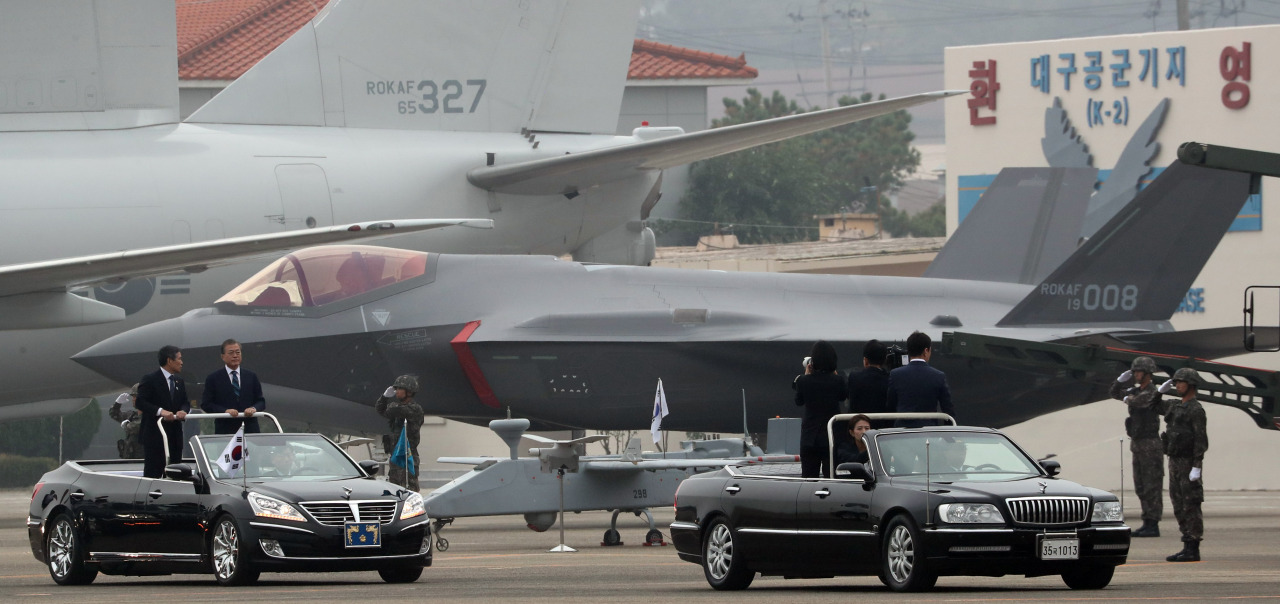One was on display, along with the country's key strategic military assets, to be inspected by President Moon Jae-in, and three conducted a ceremonial flyby.
As a centerpiece of the country's strategic targeting scheme against potential enemy forces, the warplane is expected to boost operational capabilities and strengthen the readiness posture against threats from all directions, according to Air Force officers.
The fighters can fly at a top speed of Mach 1.8 and carry top-of-the-line weapons systems, such as joint direct attack munitions. By the end of this year, South Korea is expected to introduce 13 F-35As, and it is reviewing an option to buy 20 more units, according to the officers.
North Korea has intensified its criticism against South Korea for the introduction of such advanced weaponry, claiming that such a military buildup is aimed at destroying North Korea and threatens peace on the Korean Peninsula and in the region.
Under the theme "strong armed forces alongside the people," the ceremony also involved other strategic military assets -- in stark contrast to last year's event held soon after President Moon Jae-in's third summit with North Korean leader Kim Jong-un.
For Tuesday's event, Moon arrived at the air base in a Surion, one of the country's indigenous helicopters, to demonstrate the stability of the vehicle and the excellence of the country's defense industries, according to the defense ministry.
During the event, four F-15K fighter jets took off on missions to the country's easternmost islets of Dokdo in the East Sea, the southern island of Jeju and Jik Island in the Yellow Sea, and reported their findings to the president and the people.
On the ground, key weapons from the Army, the Navy and the Air Force were on display, such as state-of-the-art unmanned aerial vehicles, Patriot Advanced Capability-3 missiles, the M-SAM missile defense system, Hyunmoo-2 short-range ballistic missiles, Haeseong-2 long-range anti-ship cruise missiles, K-9 self-propelled howitzers and the Army Tactical Missile System.
"The focus of this event was to show the people the readiness and capabilities of our strong armed forces. We hope that the people witness our overwhelming forces armed with cutting-edge technologies," the ministry said in a release.
Such a determined mood appears to reflect the grave security situation on the Korean Peninsula.
After a 18-month hiatus, North Korea resumed its major weapons tests in May and has since launched short-range projectiles in succession, involving short-range ballistic missiles.
Seoul's defense ties with other neighboring countries are also far from stable. Relations between Seoul and Tokyo have remained at the lowest ebbs in years over historic and diplomatic rows. In July, a Russian warplane violated South Korean airspace twice in the East Sea, prompting the South Korean Air Force to fire hundreds of warning shots.
"Our military's airtight security (measures) support dialogue and cooperation and enable (us) to take an audacious walk toward permanent peace," Moon said in an address during the ceremony, vowing to ensure a security posture "that nobody can make light of."
Defense Minister Jeong Kyeong-doo said, "Though the current security circumstances are quite tough, our military will surely overcome any difficulties. In order to enable South Korea to take a bold step for a permanent peace and toward the new century, the military will lend strong support with great power."
Tuesday's event was attended by some 2,500 people, including the top commanders of the country's armed services. US Forces Korea Command commander Gen. Robert Abrams did not attend the ceremony, as he is in the United States for other plans, according to the ministry.
It is the first time that an Armed Forces Day ceremony has been held at an air combat command. Officials said it is to better mark the 70th anniversary of the foundation of the Air Force that falls on the same day. (Yonhap)




![[Herald Interview] 'Trump will use tariffs as first line of defense for American manufacturing'](http://res.heraldm.com/phpwas/restmb_idxmake.php?idx=644&simg=/content/image/2024/11/26/20241126050017_0.jpg)

![[Health and care] Getting cancer young: Why cancer isn’t just an older person’s battle](http://res.heraldm.com/phpwas/restmb_idxmake.php?idx=644&simg=/content/image/2024/11/26/20241126050043_0.jpg)

